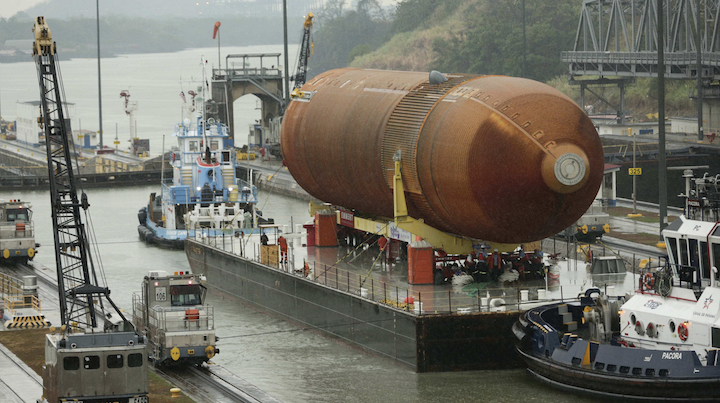[Note: The idea for and first draft of this piece arose from the brain of one Charles (Tom) Thomas, FSG Partner, at the prodding of one Peter J. Kennedy Jr., also FSG Partner.]
NASA and the Panama Canal
The other day we ran across a picture of a cargo barge transiting the Panama Canal, carrying a huge fuel tank for the NASA Space Shuttle that is being shipped to Southern California to become a tourist attraction.

The picture had particular resonance for us, since NASA (the aeronautics side) has been a client of ours over a long period of time, and also because the Panama Canal Authority (and the Panama Canal Commission before it) has also been a repeat client of ours over many years. Indeed, much of the maritime services infrastructure you can see all along the Canal now and the third set of locks and lanes were strategies that emerged in part from a scenario planning project we undertook for the Canal Commission in 1997.
But consider a deeper lesson about the future that this picture seems to represent. What NASA does is technologically sexy – incredible interplanetary missions and the development of critical high risk/high payoff technologies for aeronautics. NASA’s image clearly looks like the future of transportation. Yet, maritime trade remains the life-blood of the global economy. New ships are incredibly efficient and have low carbon footprints – they deliver bulk goods and products at price points air transportation cannot touch.
When we look at this picture, we feel pride in the work that we have done with two fantastic clients. But we also are made uneasy by the contrast between the two clients’ stances toward the future.
On the one hand, the Panama Canal will in 2016 open a third set of locks and lanes to much larger ships than have been able to transit the canal since its opening in 1914, thanks to its willingness to not only plan for the future, but also its boldness in staking the future of a tiny 2 million-population country on a staggeringly expensive bet on the next century of maritime trade.
NASA, the United States’ preeminent high-technology agency, half a century ago – about halfway back to the opening of the Panama Canal – was investing an even more staggering sum in the effort to put human beings on the moon and bring them back safely. Now, as this picture attests, NASA is essentially turning what was arguably its highest achievement into a museum piece, and is currently diffidently debating the merits of orbital space flight (been there, done that) versus another moon landing (been there, done that) versus trying for Mars. (The Chinese seem to be having the same debate, the difference being that they seem serious about actually doing something, while the American public sees the next great human exploration as a waste of their tax dollars.)
The ironies do not end there. The United States government, of course, built the Panama Canal. The ceremonial opening of the Canal, on October 10, 1913, with President Woodrow Wilson sending a telegraph signal that exploded a dike and joined the Atlantic and Pacific Oceans, was the inauguration of an era of unquestioned American supremacy in big, strategic infrastructure projects.
For most of the rest of the twentieth century, if something was the biggest or “most” in the world, it was probably built in the United States. The biggest dams, bridges and tunnels; the largest highway systems; the tallest buildings; the most advanced electrical and telecommunications grids; and the most sophisticated water and sewerage systems were built in this country.
You do not have to live in Flint, Michigan to know that the infrastructure of the United States is no longer leading the world. Lead in water systems is reportedly a problem countrywide, with 350 communities nationwide providing high-lead water to schools and day care facilities, according to USA Today. The broader infrastructure of the country is also falling down. The U.S. received a D+ mark on its infrastructure from the Society of Civil Engineers in 2013; the report stated that we needed $3.6 trillion in investment in our infrastructure by 2020 to bring it up to par. Drinking water received a D; inland waterways and levees, D-. In the 3 years since, little has been done to appropriate, much less spend, the funding SCE proposed.
Yet these statistics do not begin to describe the real problem, because that $3.6 trillion would merely bring our infrastructure back to where it was in the past. It would not even begin to address where we OUGHT to be in the future.
Sheiks in Dubai fight to build the next half-mile-tall building. Singapore, Beijing and Malaysia build airports light-years beyond our best, with amenities such as butterfly gardens and 24-hour movie theaters. China builds an entire interstate highway system and an east-west rail system (highest-altitude in the world) inside of a decade. And little countries like Panama bet their futures on prodigious infrastructure projects.
While we fight over who will pay to fix some of the thousands of bridges that are threatening to fall down nationwide, while our states “save money” by poisoning whole cities with “cheaper” water supplies, while we are paralyzed by the problem of how to bring our infrastructure back to 1960s-era state of good repair, the rest of the world is not idle. Much of the rest of the world is actually planning for, and creating, the future.
So as you watch this ship carry part of our most glorious technological accomplishment through the canal we built a century ago, ask yourself whether we 315 million Americans in 2016, richer by most measures than at any time in our history (GDP/capita $56,000), would give the go-ahead to the Panama Canal if it were proposed now.
Imagine trying to get that forward-thinking visionary idea through Congress today.
Future greatness does not just happen. It must be planned, and then it must be provisioned. Panama, with a per-capita income of $11,849, is at least trying to do that.
What has happened to us?

One additional note. In
One additional note. In writing this piece, I was certainly influenced by Stephen Cohen and J. Bradford DeLong’s new book Concrete Economics: The Hamilton Approach to Economic Growth and Policy. I highly recommend it. https://www.amazon.com/Concrete-Economics-Hamilton-Approach-Economic-ebook/dp/B00O92Q6C6